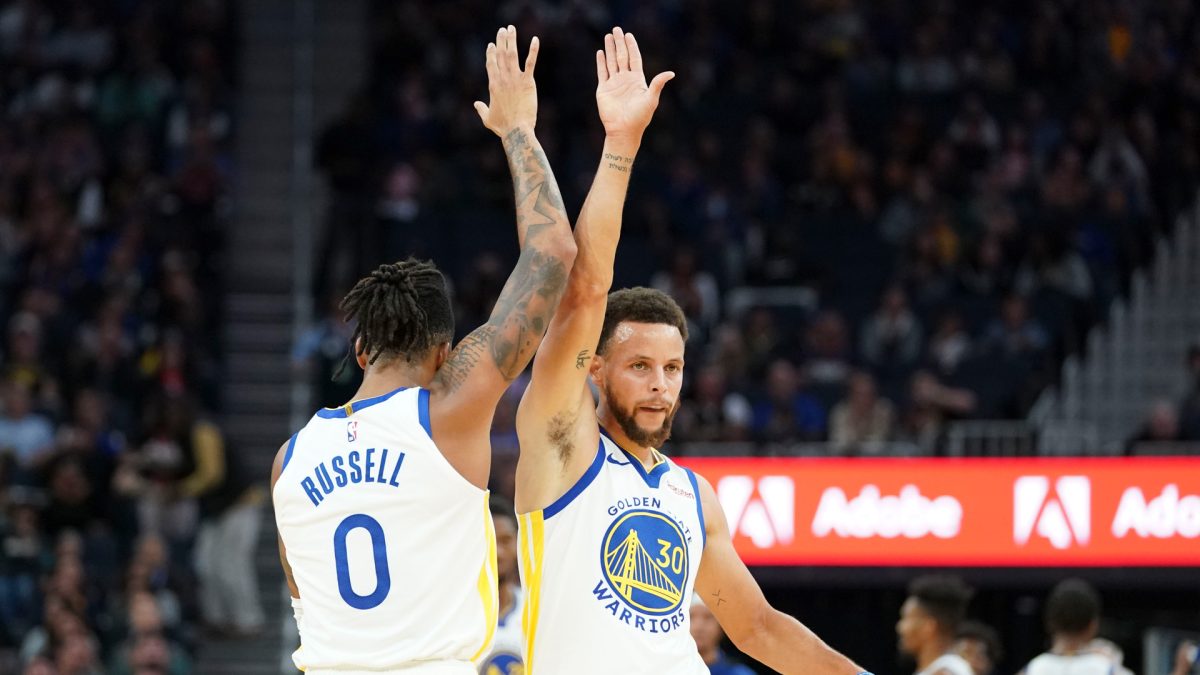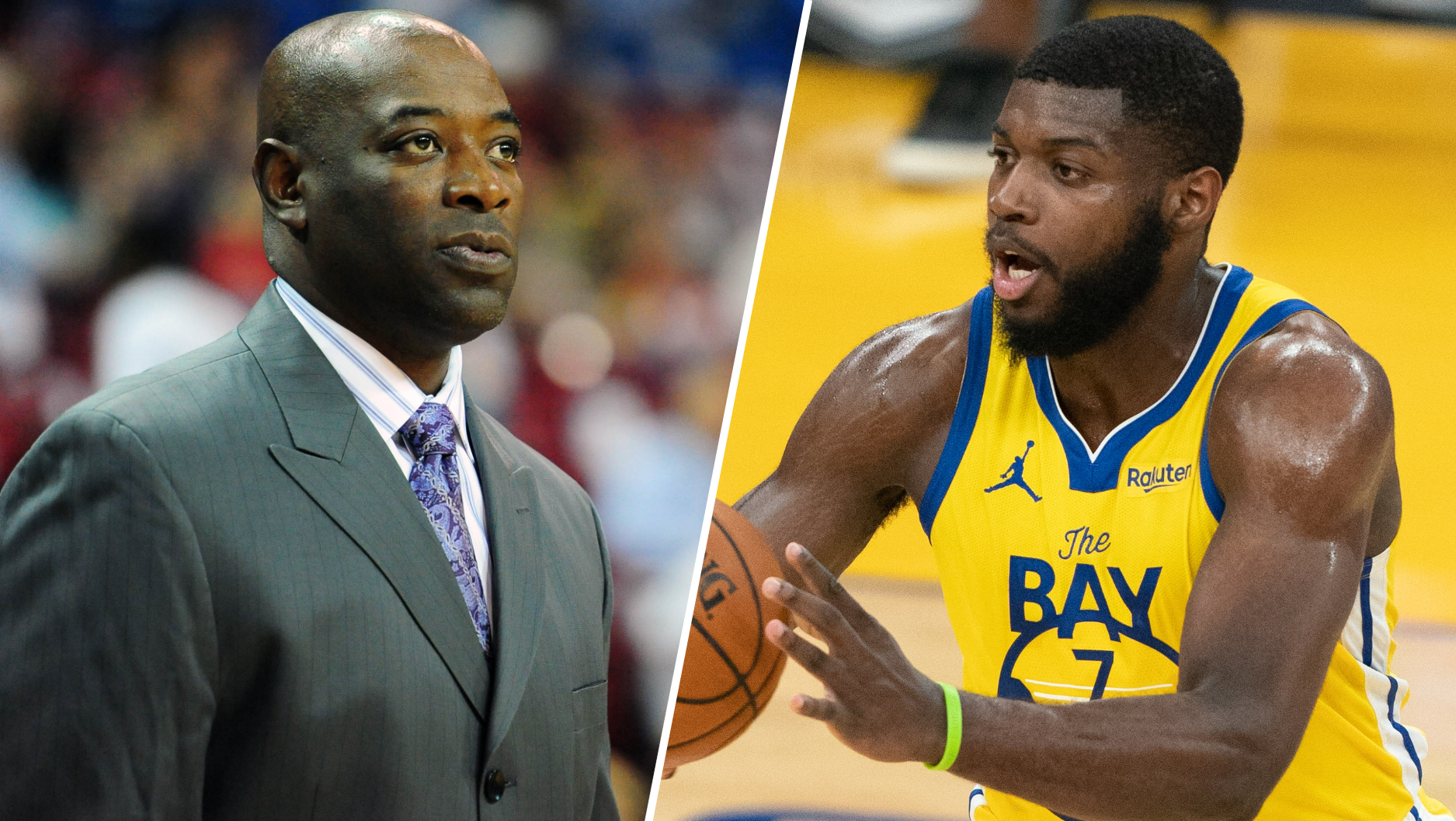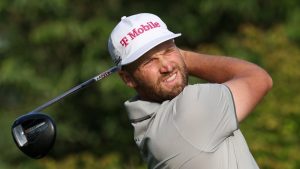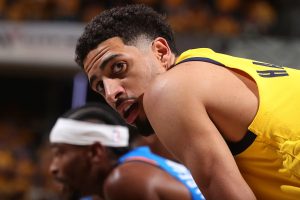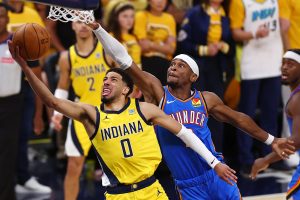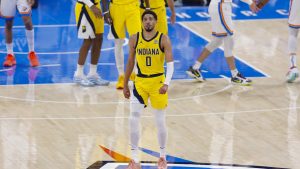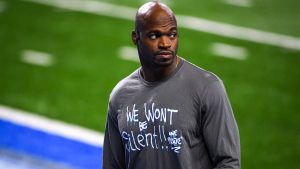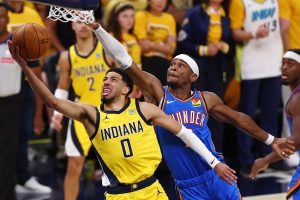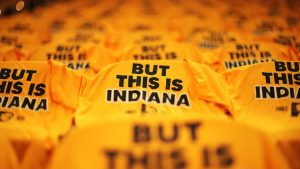Warriors’ 2025 NBA offseason has to start with shooting, scoring firepower originally appeared on NBC Sports Bay Area
If the Oklahoma City Thunder end the Indiana Pacers’ season Thursday night, or simply win one of the next two games in the 2025 NBA Finals, the age-old adage of “defense wins championships” can take a victory lap.
The Thunder had the best defense all regular season, and that continued in the playoffs. Their league-best 106.6 defensive rating has dropped to 105.9 in the playoffs, with one or two games remaining. They averaged 10.3 steals per game in the regular season, and that number has jumped to 10.9 in the playoffs. OKC’s defense circles its prey, swarms, and in thunderous unison releases the Kraken to send a dagger through their opponents.
Having a 26-year-old MVP who’s a modernized throwback scoring machine that averaged 32.7 points per game to lead the NBA this season certainly helps. So does having a No. 2 who can score all over the floor. Jalen Williams has increased his scoring output in each of the first five games of the Finals, putting 40 on the Indiana Pacers to take a three-games-to-two series lead in Game 5.
Wherever the Warriors have been watching the Finals, they could be shaking their heads and sweating at the mere thought of going against the Thunder’s defense for a playoff series in the alternate universe that a healthy Steph Curry led them past the Minnesota Timberwolves and into the Western Conference Finals. In the real world of how the Warriors’ season unfolded with an injured Curry watching from the sidelines, however, the front office should have seen that more shooting and scoring firepower will be needed to get past the Thunder and anybody else if they want to climb the mountain once more in the next two years of Curry, Jimmy Butler and Draymond’s Green contracts.
“When Steph went out, the lack of shooting was an issue, and that impacted Draymond, it impacted Jimmy, impacted [Jonathan Kuminga],” Steve Kerr said after the season. “So those are things that we have to figure out for sure.”
In the four games of the conference semifinals that Curry missed because of his strained hamstring, the Warriors only made 38 threes and shot 31.9 percent. As the Timberwolves kept missing, the Warriors made 18 threes in their Game 1 win when Curry had 13 points and three 3-pointers in just 13 minutes. They made 11 threes in that win after his exit, but five came from Buddy Hield.
The other six were from a combination of Green, Butler, Kuminga and Gary Payton II, four players considered “non-shooters” from deep. The Warriors in Game 2 through 5 averaged 9.5 threes per game, five fewer than the Timberwolves’ average of 14.5.
Plenty of question marks surround the Warriors going into the offseason. There’s one certainty: If healthy, Curry, Butler and Green will all be in the starting five as the trio that makes everything go. When those three are on the floor together, the Warriors like their chances against anyone. It also complicates a couple of things.
“Obviously with Steph, he’s such a unique player and creates so much gravity, but Jimmy and Draymond are unique in their own rights,” Warriors general manager Mike Dunleavy said last month. “Jimmy’s ability to get to the line, it’s a highly efficient way to score and get to the basket and those things.
“We’ve got ways to be a really good offense, but it’s just maybe not as traditional in 2025 as some of these other clubs.”
Simply said, the Warriors can’t be a five-out team with both Butler and Green in the lineup. Can they even be a four-out team? On a list that could be long, shooting and scoring have to be the Warriors’ main priority entering the NBA draft, free agency and possibly conducting their next trade.
That can come through multiple avenues, including internally. It’s no surprise that the best offensive rating of a three-man unit for the Warriors that included Butler and Green was inserting Curry (117.8 offensive rating). But Moses Moody and Brandin Podziemski were the two players who spent the most regular-season minutes next to Butler and Green.
Moody in the final 28 games of the regular season when he became an everyday starter shot 36.8 percent from three with 1.3 steals per game as a steady two-way player. From Jan. 1 to the end of the regular season, a 48-game span, Moody was a 37.6 percent 3-point shooter on five attempts per game. He then shot 33.3 percent in the playoffs, went four consecutive games without a made three, and was a shell of himself offensively.
The Warriors then announced Moody underwent surgery to repair a torn UCL in his right shooting thumb less than a week after the season ended. Like Moody, health surely played a part in Podziemski’s playoff shooting struggles.
Podziemski played 26 regular-season games after the Butler trade and shot 41.7 percent from three on six attempts per game. He averaged 15 points per game in that span, and then 11.3 points per game in the playoffs on 32.8 percent beyond the arc. Forty percent of his points in the playoffs came from two games.
And then the Warriors announced Podziemski has gone through left wrist surgery and surgery to repair a core muscle injury this offseason. The healthy sample sizes of Podziemski and Moody, especially with how they fit their roles once Butler was aboard, has to make the Warriors feel confident moving forward.
Hield was brought in to pick up the 3-point slack from Klay Thompson’s departure, and he fulfilled that need by making at least 200 threes for a seventh straight season. He also averaged 9.3 points and shot 31 percent from three for a two-month stretch. Hield is hot and cold, rarely finding a middle ground.
The reality of a possible Kuminga return as a restricted free agent only intensifies the need for more shooting. Curry has played at least 70 games the last two seasons, and that number should be expected to drop next season and the season after. A scorer like Kuminga can help ease that burden, but only if the proper shooting is around him, spacing the floor for driving room to the basket.
Size is undoubtedly part of the priority list. Height might not matter much if the player can’t stretch the floor like we’re seeing by the last two teams standing from players like Chet Holmgren and Myles Turner. The Pacers have a true five-out starting lineup, and the Thunder led the NBA in 3-point percentage once the calendar moved to 2025.
The NBA offseason began before the season even ended when the Orlando Magic traded for Desmond Bane on Sunday. Why did the Magic send Kentavious Caldwell-Pope, four first-round picks and a future pick swap to the Memphis Grizzlies for someone who’s yet to make an All-Star team in his first five seasons? Because Bane’s scoring ability as someone who has averaged more than 20 points twice, and shooting 41 percent behind the 3-point line for his career, is exactly what the Magic have been missing.
Making it further than a second-round exit is the expectation after understanding who the Warriors are in the Butler era. The only way that will happen is if the main investment the next few weeks and throughout the summer is circling players who can put points on the scoreboard and make the nets drip once again inside Chase Center, and beyond.
Download and follow the Dubs Talk Podcast
Warriors’ 2025 NBA offseason has to start with shooting, scoring firepower
If the Oklahoma City Thunder end the Indiana Pacers’ season Thursday night, or simply win one of the next two games in the 2025 NBA Finals, the age-old adage of “defense wins championships” can take a victory lap.
The Thunder had the best defense all regular season, and that continued in the playoffs. Their league-best 106.6 defensive rating has dropped to 105.9 in the playoffs, with one or two games remaining. They averaged 10.3 steals per game in the regular season, and that number has jumped to 10.9 in the playoffs. OKC’s defense circles its prey, swarms, and in thunderous unison releases the Kraken to send a dagger through their opponents.
Having a 26-year-old MVP who’s a modernized throwback scoring machine that averaged 32.7 points per game to lead the NBA this season certainly helps. So does having a No. 2 who can score all over the floor. Jalen Williams has increased his scoring output in each of the first five games of the Finals, putting 40 on the Indiana Pacers to take a three-games-to-two series lead in Game 5.
Wherever the Warriors have been watching the Finals, they could be shaking their heads and sweating at the mere thought of going against the Thunder’s defense for a playoff series in the alternate universe that a healthy Steph Curry led them past the Minnesota Timberwolves and into the Western Conference Finals. In the real world of how the Warriors’ season unfolded with an injured Curry watching from the sidelines, however, the front office should have seen that more shooting and scoring firepower will be needed to get past the Thunder and anybody else if they want to climb the mountain once more in the next two years of Curry, Jimmy Butler and Draymond’s Green contracts.
“When Steph went out, the lack of shooting was an issue, and that impacted Draymond, it impacted Jimmy, impacted [Jonathan Kuminga],” Steve Kerr said after the season. “So those are things that we have to figure out for sure.”
In the four games of the conference semifinals that Curry missed because of his strained hamstring, the Warriors only made 38 threes and shot 31.9 percent. As the Timberwolves kept missing, the Warriors made 18 threes in their Game 1 win when Curry had 13 points and three 3-pointers in just 13 minutes. They made 11 threes in that win after his exit, but five came from Buddy Hield.
The other six were from a combination of Green, Butler, Kuminga and Gary Payton II, four players considered “non-shooters” from deep. The Warriors in Game 2 through 5 averaged 9.5 threes per game, five fewer than the Timberwolves’ average of 14.5.
Golden State Warriors
Find the latest Golden State Warriors news, highlights, analysis and more with NBC Sports Bay Area and California.
Plenty of question marks surround the Warriors going into the offseason. There’s one certainty: If healthy, Curry, Butler and Green will all be in the starting five as the trio that makes everything go. When those three are on the floor together, the Warriors like their chances against anyone. It also complicates a couple of things.
“Obviously with Steph, he’s such a unique player and creates so much gravity, but Jimmy and Draymond are unique in their own rights,” Warriors general manager Mike Dunleavy said last month. “Jimmy’s ability to get to the line, it’s a highly efficient way to score and get to the basket and those things.
“We’ve got ways to be a really good offense, but it’s just maybe not as traditional in 2025 as some of these other clubs.”
Simply said, the Warriors can’t be a five-out team with both Butler and Green in the lineup. Can they even be a four-out team? On a list that could be long, shooting and scoring have to be the Warriors’ main priority entering the NBA draft, free agency and possibly conducting their next trade.
That can come through multiple avenues, including internally. It’s no surprise that the best offensive rating of a three-man unit for the Warriors that included Butler and Green was inserting Curry (117.8 offensive rating). But Moses Moody and Brandin Podziemski were the two players who spent the most regular-season minutes next to Butler and Green.
Moody in the final 28 games of the regular season when he became an everyday starter shot 36.8 percent from three with 1.3 steals per game as a steady two-way player. From Jan. 1 to the end of the regular season, a 48-game span, Moody was a 37.6 percent 3-point shooter on five attempts per game. He then shot 33.3 percent in the playoffs, went four consecutive games without a made three, and was a shell of himself offensively.
The Warriors then announced Moody underwent surgery to repair a torn UCL in his right shooting thumb less than a week after the season ended. Like Moody, health surely played a part in Podziemski’s playoff shooting struggles.
Podziemski played 26 regular-season games after the Butler trade and shot 41.7 percent from three on six attempts per game. He averaged 15 points per game in that span, and then 11.3 points per game in the playoffs on 32.8 percent beyond the arc. Forty percent of his points in the playoffs came from two games.
And then the Warriors announced Podziemski has gone through left wrist surgery and surgery to repair a core muscle injury this offseason. The healthy sample sizes of Podziemski and Moody, especially with how they fit their roles once Butler was aboard, has to make the Warriors feel confident moving forward.
Hield was brought in to pick up the 3-point slack from Klay Thompson’s departure, and he fulfilled that need by making at least 200 threes for a seventh straight season. He also averaged 9.3 points and shot 31 percent from three for a two-month stretch. Hield is hot and cold, rarely finding a middle ground.
The reality of a possible Kuminga return as a restricted free agent only intensifies the need for more shooting. Curry has played at least 70 games the last two seasons, and that number should be expected to drop next season and the season after. A scorer like Kuminga can help ease that burden, but only if the proper shooting is around him, spacing the floor for driving room to the basket.
Size is undoubtedly part of the priority list. Height might not matter much if the player can’t stretch the floor like we’re seeing by the last two teams standing from players like Chet Holmgren and Myles Turner. The Pacers have a true five-out starting lineup, and the Thunder led the NBA in 3-point percentage once the calendar moved to 2025.
The NBA offseason began before the season even ended when the Orlando Magic traded for Desmond Bane on Sunday. Why did the Magic send Kentavious Caldwell-Pope, four first-round picks and a future pick swap to the Memphis Grizzlies for someone who’s yet to make an All-Star team in his first five seasons? Because Bane’s scoring ability as someone who has averaged more than 20 points twice, and shooting 41 percent behind the 3-point line for his career, is exactly what the Magic have been missing.
Making it further than a second-round exit is the expectation after understanding who the Warriors are in the Butler era. The only way that will happen is if the main investment the next few weeks and throughout the summer is circling players who can put points on the scoreboard and make the nets drip once again inside Chase Center, and beyond.
Download and follow the Dubs Talk Podcast
This article tagged under:


